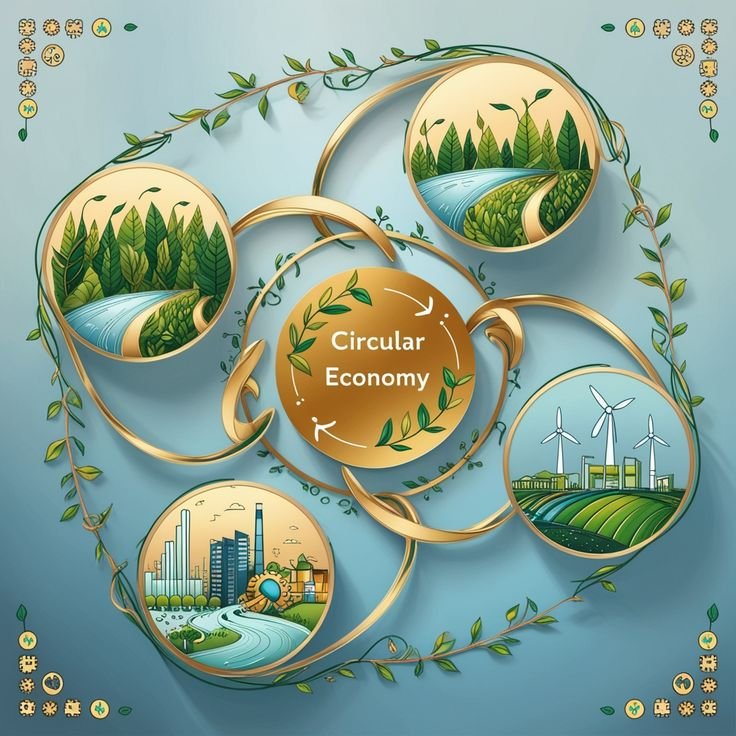The Role of Circular Economy in Reducing Environmental Impact

Introduction
In today’s world, the escalating environmental challenges caused by unsustainable consumption and production practices have become a global concern. The linear “take-make-dispose” economic model, which has dominated industrial development for decades, is proving to be detrimental to the planet. This model leads to resource depletion, environmental degradation, and excessive waste generation. In response to these challenges, the concept of the circular economy has emerged as a sustainable alternative. A circular economy aims to eliminate waste and pollution, circulate products and materials, and regenerate natural systems. By closing the loop, this approach offers a transformative pathway toward sustainability, reducing environmental impact while fostering economic growth.
This article explores the role of the circular economy in addressing pressing environmental issues. It examines the principles underpinning the circular economy, its benefits, and practical applications across various industries. Additionally, it highlights the challenges and opportunities for implementing circular economy practices on a global scale. By understanding and adopting circular economy principles, societies can transition toward a more sustainable future.
Section 1: Understanding the Circular Economy
The circular economy is based on three core principles: designing out waste and pollution, keeping products and materials in use, and regenerating natural systems. Unlike the linear economy, which relies on the extraction of finite resources, the circular model prioritizes resource efficiency and sustainability.
1.1 Principles of Circular Economy
- Designing Out Waste and Pollution: This involves rethinking product design to minimize waste and reduce environmental harm. Innovations such as modular designs and biodegradable materials support this principle. These design choices not only make products easier to repair and recycle but also reduce the dependency on virgin materials.
- Keeping Products and Materials in Use: By extending the life cycle of products through repair, refurbishment, and recycling, the circular economy reduces resource consumption and waste generation. It encourages practices such as leasing, sharing, and modular upgrades, allowing businesses and consumers to maximize the value derived from products.
- Regenerating Natural Systems: Circular practices, such as composting organic waste and restoring ecosystems, contribute to the health of natural systems. They ensure that resources are returned to the earth in a way that enriches rather than depletes natural capital.
1.2 Historical Context and Evolution
The circular economy concept has roots in traditional practices, such as reuse and recycling, but has gained significant attention in recent decades. Influenced by frameworks like cradle-to-cradle design and industrial ecology, the circular economy represents a paradigm shift in how resources are managed. Its historical evolution underscores the increasing urgency to transition from exploitative practices to regenerative systems.
1.3 The Circular Economy vs. Linear Economy
The contrast between circular and linear economic models highlights the transformative potential of circularity. The linear model is resource-intensive and generates significant waste, whereas the circular economy seeks to create closed loops where resources are continuously reused. This paradigm shift requires a redefinition of value, emphasizing longevity and sustainability over disposability.
Section 2: Environmental Benefits of the Circular Economy
Adopting a circular economy model can significantly reduce environmental impacts. This section explores how circular practices address key environmental challenges and contribute to sustainability.
2.1 Waste Reduction
- Circular systems reduce the volume of waste sent to landfills and incinerators. By designing products for durability and repairability, less material is discarded, and resources remain in circulation.
- Case Studies: E-waste recycling initiatives have shown significant reductions in electronic waste. For example, companies that offer take-back programs for old electronics ensure responsible recycling and reuse of valuable materials.
2.2 Resource Conservation
- Circular practices optimize the use of finite resources like minerals, metals, and fossil fuels. Efficient resource management reduces extraction pressures on the environment.
- Examples: Water reuse systems in agriculture and urban settings demonstrate how circular methods conserve vital resources. Closed-loop water systems not only save water but also reduce energy consumption associated with water treatment and transport.
2.3 Mitigating Climate Change
- By reducing energy consumption and promoting renewable energy, the circular economy helps lower greenhouse gas emissions. The adoption of energy-efficient technologies and renewable resources aligns with global climate goals.
- Example: Circular approaches in the energy sector, such as retrofitting buildings with energy-efficient technologies and incorporating renewable energy systems, showcase significant reductions in carbon footprints.
2.4 Biodiversity Preservation
- Circular practices minimize habitat destruction and promote ecosystem restoration. By avoiding deforestation and mining, circular systems protect biodiversity hotspots.
- Example: Regenerative agriculture supporting soil health and biodiversity is a critical component of circular practices. This approach ensures that farming practices replenish natural ecosystems rather than depleting them.
2.5 Pollution Prevention
- Circular systems prevent pollution by minimizing waste, reducing reliance on harmful chemicals, and promoting clean production methods. Cleaner production practices reduce air, water, and soil contamination, improving overall ecosystem health.
Section 3: Circular Economy in Action
The principles of the circular economy are being applied across various industries, showcasing its potential to drive sustainable development and reduce environmental harm.
3.1 Circular Economy in Manufacturing
- Transitioning from mass production to modular and repairable designs enables manufacturers to reduce waste and extend product lifespans. Manufacturing processes are becoming more efficient and less resource-intensive.
- Case Studies: Companies implementing closed-loop manufacturing processes, such as utilizing industrial byproducts as raw materials, demonstrate the viability of circular systems in reducing waste.
3.2 Circular Practices in Agriculture
- Adopting regenerative farming techniques to restore soil fertility, enhance water retention, and increase biodiversity supports sustainable food systems.
- Example: Agroecology and permaculture projects promote practices like crop rotation, polyculture, and composting, ensuring that agriculture remains productive and environmentally friendly.
3.3 Circular Economy in Urban Development
- Smart cities are integrating circular economy principles in waste management, energy use, and construction. Urban environments serve as laboratories for testing circular innovations.
- Example: Urban symbiosis projects, where industries collaborate to utilize each other’s byproducts, showcase how cities can adopt circular practices to improve sustainability.
3.4 Circular Solutions in the Fashion Industry
- Embracing slow fashion, recycling textiles, and adopting sustainable materials revolutionize the fashion industry. Circular business models in fashion emphasize quality, repairability, and resale.
- Examples: Brands pioneering circular fashion lines that use recycled materials and offer repair services are reshaping consumer expectations.
3.5 Circular Innovations in Technology
- Extending the lifespan of electronics through repair and remanufacturing reduces e-waste. Circular practices in technology prioritize modular designs and material recovery.
- Example: Companies implementing take-back schemes for electronics recycling are leading the way in reducing technological waste.
3.6 Circular Economy in Food Systems
- Tackling food waste through redistribution, composting, and anaerobic digestion exemplifies circular practices in the food sector. Ensuring that food waste is repurposed prevents methane emissions and enriches soils.
Section 4: Challenges in Implementing Circular Economy Practices
Despite its benefits, the transition to a circular economy faces several challenges that must be addressed to ensure widespread adoption.
4.1 Economic and Market Barriers
- High initial costs of adopting circular practices deter businesses from transitioning. Lack of financial incentives and support systems exacerbates these challenges.
- Examples: Small businesses struggle to invest in circular technologies without subsidies or access to affordable financing.
4.2 Policy and Regulatory Gaps
- Inconsistent policies and lack of enforcement hinder the adoption of circular economy practices. Governments need to implement robust frameworks that encourage circularity.
- Examples: Countries without standardized recycling laws face difficulties in managing waste effectively.
4.3 Technological Constraints
- Limited access to advanced technologies required for circular processes creates significant barriers. Complex materials, such as multi-layer plastics, remain challenging to recycle efficiently.
- Examples: Research and development efforts are needed to address these technological gaps and improve recycling efficiency.
4.4 Behavioral and Cultural Resistance
- Consumer habits and lack of awareness about circular practices hinder adoption. Behavioral change initiatives and education campaigns are essential to overcome resistance.
- Strategies: Promoting behavioral change through community engagement, awareness campaigns, and incentives for sustainable choices.
4.5 Infrastructure Limitations
- Inadequate infrastructure for recycling and waste management in many regions slows progress toward circularity. Investments in infrastructure are critical to scaling circular practices.
Section 5: Opportunities and Strategies for Scaling Up
Overcoming the challenges requires collaborative efforts from governments, businesses, and individuals. This section explores strategies to scale up circular economy practices.
5.1 Policy Interventions
- Governments play a critical role in creating enabling environments through incentives and regulations. Policy frameworks that promote circularity are essential for driving change.
- Examples: Extended producer responsibility (EPR) programs and green public procurement policies incentivize businesses to adopt circular practices.
5.2 Business Innovation
- Companies adopting innovative business models, such as product-as-a-service and sharing economy platforms, demonstrate the commercial viability of circular systems.
- Examples: Car-sharing services and subscription-based electronics showcase how businesses can thrive in a circular economy.
5.3 Technological Advancements
- Development of technologies that facilitate recycling, remanufacturing, and resource recovery is crucial for scaling up circular practices.
- Example: AI-driven waste sorting systems and advanced material recovery technologies enable efficient resource use.
5.4 Public Awareness Campaigns
- Raising awareness about the benefits of the circular economy through education and advocacy helps build support for circular practices. Community engagement fosters collective action.
- Examples: Community-led recycling programs, eco-friendly product labeling, and educational initiatives promote circularity at the grassroots level.
5.5 International Collaboration
- Sharing knowledge, resources, and best practices across borders accelerates the transition to a global circular economy. International partnerships amplify the impact of local efforts.
- Example: Global initiatives like the Ellen MacArthur Foundation’s Circular Economy Program and the UN’s Sustainable Development Goals (SDGs) provide platforms for collaboration.
5.6 Role of Technology in Scaling Circular Systems
- Innovations such as blockchain for material tracking and IoT devices for monitoring resource use enable more efficient circular systems.
Conclusion
The circular economy presents a transformative approach to addressing the environmental challenges posed by the linear economic model. By prioritizing waste reduction, resource efficiency, and ecosystem regeneration, the circular economy offers a sustainable pathway for economic and environmental well-being. While challenges remain, the growing adoption of circular practices across industries and regions signals a positive shift toward sustainability. Governments, businesses, and individuals must collaborate to scale up these efforts and ensure a more resilient and equitable future. Embracing the circular economy is not just an environmental necessity but an opportunity to redefine prosperity in harmony with the planet. By integrating innovative strategies and fostering international cooperation, the transition to a circular economy can drive lasting change, ensuring a thriving planet for future generations.




One Comment